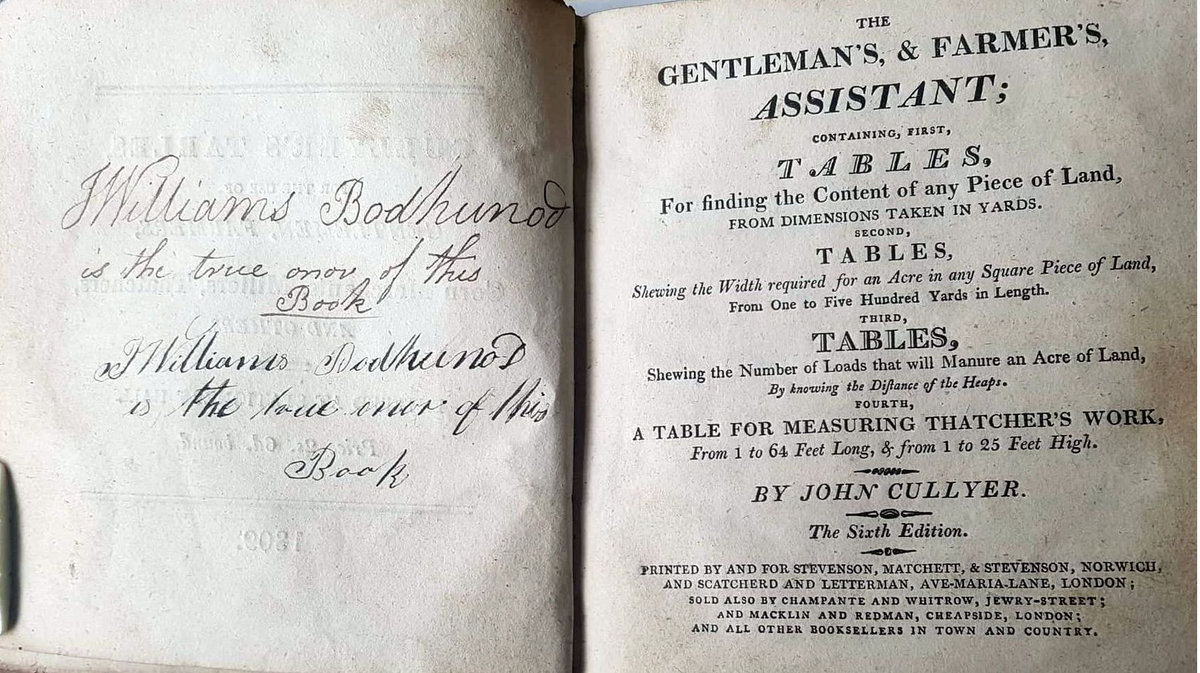Two book purchases from Clarach Market
Two interesting book purchases from Clarach Market
Six or seven years ago I bought two early nineteenth-century ready reckoners at the car-boot section of the Clarach Sunday Market for the princely sum of two pounds apiece. This was a category of publication once common in every shop or business but have now virtually disappeared except for all but the most specialised applications. Having purchased them, I put them on my bookshelves and promptly forgot about both of them. However, the Covid-19 lockdown, plus the fiftieth anniversary of our currency decimalisation have given me the time and an incentive to do some further investigation.
In the days before the advent of electronic calculators, decimal currency, or metric weights and measures, the ready reckoner was an essential tool in almost every business. It consisted of tables in book or sheet form. containing pre-calculated values. The earliest printed survival of which dates from the 1570s (ESTC S112011) and there are plenty of seventeenth century publications giving ‘reckonings ready done’ or ‘accounts ready cast up’. The most popular was William Leybourn’s, Panarithmologia, being a mirror breviate treasure mate for merchants, bankers, tradesmen, mechanicks, and a sure guide for purchasers, sellers, or mortgagers of land, leases, annuities, rents, pensions, &c. in present possession or reversion. 1693. However, the term ‘ready reckoner’ was coined by the schoolmaster Daniel Fenning with the publication of The ready reckoner; or trader's most useful assistant, in 1757, which was a modernised and extended version Leybourn’s work. My first purchase was of an 1808 edition, of Fenning, ’carefully revised and corrected, by Joseph Moon, Mathematician, Salisbury’.

The extended title set out the purpose of the work:
… Trader's most useful assistant in buying and selling all sorts of commodities either Wholesale or Retail. Shewing at one View The Amount or Value of any Number or Quantity of Goods or Merchandise from one Farthing progressively up to Twenty Shillings, either by the long or short Hundred, Half Hundred or Quarter, Pound or Ounce, Ell or Yard, &c. &c. In so plain and easy a Manner, that even a Child may hereby ascertain the Amount of any Number of Hundreds, Pounds, Ounces, Ells or Yards, &c. at any Price whatever from one Farthing to Twenty Shillings. And to the most ready in Figures, it will be equally useful by saving a great Deal of Time in casting-up, what is here correctly done to their Hand. To which is added, a double table of Portugal money from 1 to 1000. Also A Table of Expences or Wages by the Day, Week, Month or Year. With a table of annuities and Commission or Brokerage from one to one Eighth per Cent. And several other necessary and instructive Things.
Fenning’s tables had been in constant demand from their first publication with around fifty editions listed in the English Short-title Catalogue by 1800. It was also soon being copied or adapted, especially in Scotland and North America where the currency and weights and measures were different. Yet my 1808 copy was described as the ‘13th edition,’ which is probably an indication of the numbers of revisions to the text that hat taken place rather than the number separate printings. Joseph Moon’s revisions had begun to appear in the eighth edition of 1785. The accuracy of the printed tables was of paramount importance, thus Moon assured his readers in a preface that ‘Every Sheet of this Impression was carefully and repeatedly compared with the Editor’s corrected Copy previous to its being worked off.’ Moon was also conscious of the rivals and piracies of the work in circulation. He therefore added a note ‘The great Repute and rapid Sale of this Book, have given rise to many imperfect impressions of it; the Public are therefore respectfully informed that every genuine Copy is signed with the name of the Editor, Joseph Moon’ with a printed facsimile of his signature.
According to its imprint my copy was ‘printed for’ seven of the best-known publishers then in London and B.C. Collins in Salisbury, although the colophon on the last page indicates that it was printed in Salisbury by Collins. Since Collins’ name is also found on the imprints of most of the eighteenth-century editions, this makes me suspect that they too may have been printed in Salisbury.
Whereas Fenning’s work as a general-purpose ready reckoner, the second title that I purchased was specifically aimed at the needs of ‘Gentleman farmers, corn merchants, millers and thatchers.’ The gentleman and farmers' assistant by John Cullyer consisted of ‘tables for finding the content of any piece of land from dimension taken in yards’, tables shewing the width required for an acre in any square piece of land from 1 to 500 yards in length, a table shewing the number of loads that will manure an acre of land by knowing the distance of the heaps and a table for measuring thatcher’s work. The compiler states that his work ‘will be found serviceable in settling trifling disputes between Masters and their Workmen, where, in general, the difference is not of sufficient magnitude to pay a proper Person for surveying it.’ He too provided a preface incorporating a facsimile of his signature, presumably as a means of lending authenticity to the work.

John Cullyer was a minor gentleman living in Wicklewood, a hamlet adjoining the Norfolk market town of Wymondham. His tables first appeared in Norwich in 1795, ‘published by their author’. A second edition (1798) was ‘Entered at Stationer’s Hall’ and the third edition, 1800, was published commercially with several London distributors listed on the imprint together with the statement sold by ‘all other booksellers, in town and country’. By the fourth edition of 1803 the work was being published jointly in Norwich and London. I purchased the sixth edition, 1809, ‘Printed by and for Stevenson, Matchett & Stevenson Norwich; and Scatcherd and Letterman, Ave Maria Lane, London. At two shillings and sixpence, bound, this was not cheap, but its continued popularity is attested by the existence of a 15th edition [1872] and an undated 17th edition published in London by Whittaker & Co .The success of his work also encouraged Cullyer to compile an Improved ready reckoner in 1807, presumably also based on Fenning’s work, although this never achieved great popularity, perhaps because of the continued popularity of the original. My main interest was as an example of early Norwich printing, although there is also an interesting list of agricultural works offered by the publishers including The practical Norfolk farmer, The farmer’s and gardener’s directory, A treatise on land surveying, and The formation and management of floated meadows.
Both my ready reckoners predate the Weights and Measures Act of 1824 and the establishment of standardised Imperial Units; they both contain clues which indicate how chaotic and subject to dispute traditional weights and measures had become at the beginning of the 19th century. To give a few examples, Fenning provided various definitions ‘very necessary to be known in various Branches of Business’. From this one discovers that ‘A Barrel of Anchovies is about 18lb’ whereas ‘A Barrel of Herrings is 500lb’ and ‘A Barrel of Gunpowder’ ‘112lb’. On the other hand, ‘A Barrel of Ale’ contained 32 Gallons but ‘A Barrel of Beer,’ 36 Gallons.’ A ‘Clove of Cheese’ weighed 8lb but ‘A Clove of Wool’ 7lb. A ‘Wey’ consisted of 5 Chaldrons, although ‘A Wey of Cheese in Essex was 32 Cloves, or 256lb. but in Suffolk it was 42 Cloves, or 336lbs. ‘A Ton’ was defined as 20cwts but ‘A Ton of Lead’ weighed only 19½ cwt. Similarly, Cullyer gave ‘preference to Dimensions taken in Yards, rather than Rods, or Chains and Links, as all Farmers can tell the Length and Breadth of a Piece of Land in Yards, very near the truth, by only PACING it.’ He also speaks of the ‘various disputes which daily arise respecting the Measure of Corn (by the Winchester Bushel, and by those generally used by Farmers)’ which gave rise to an additional table showing the content of any bushel in pints.
Each of my purchases was still in its original sheepskin binding and showed signs of having been used regularly. The Fenning/Moon edition contained the neat inscription ‘Bulford Mill’ 1821 and several florid practice signatures of a ‘William Godwin’. There is also an inscription in a different hand ‘William Godwin of Bulford for his hiring. H. White'(?), followed by the date Martch 14th 1863. The front endpapers and some other blank spaces in the book contain a number of calculations, the last of which was for 28.15.0 ½ and dated Oct. 1913. There are two Bulford Mills: a water and steam mill at Cressing in Essex and a paper mill at Bulford in Wiltshire. The latter seems to have been the home of my volume and the 1851 census lists a Charles Godwin paper maker together with his wife and three daughters.

The Cullyer volume had a Welsh connection. It included a signature of an otherwise unidentified Robert Byshe Jnr and several ownership inscriptions (one of which is dated 1820) by John Williams of Bodhunod, and of Bodewryd. Both of these places are in Anglesey a few miles from Amlwch: Bodewryd is a parish which had a population of 22 souls in the 1940s. Bodhunod was the name of a farmstead. The 1801 census identifies two adjacent houses, Bodhunod where John Williams lived with his wife, four children and two servants and Bodhunod Bach occupied by Richard Charles, his wife and two daughters. The Royal Cambrian Academy artist Audrey Hind has painted a picture of Bohunod as it was a few years ago.
David Stoker (das@aber.ac.uk) February 2021.
